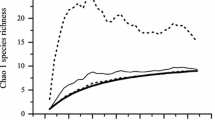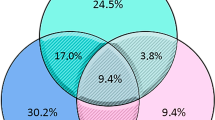Abstract
Leaf-cutting ants (Formicidae: Attini) are considered pests in agriculture for their impact in human crops, as they utilize leaf fragments to raise their fungal mutualist (Agaricales: Lepiotaceae). Basically, the basidiomycetous fungus is cultivated to supply food to adult workers and broads; in return, the ants protect it against natural enemies. However, recent studies have claimed that other microorganisms are associated to ant nests where a wide range of interactions may take place. To investigate the occurrence of dematiaceous fungi on the cuticle of Atta laevigata ants, 30 workers were sampled from an adult nest located in the surroundings of the Center for the Studies of Social Insects, UNESP-Rio Claro, SP, Brazil. The use of selective techniques to avoid high-sporulation fungi has been recommended and was tested in this study. To favor the isolation of the desired fungi, heads and cuticle scrapings of ant bodies were inoculated on Mycosel agar and incubated for 3 weeks at 35°C. Morphological and molecular methods were used to identify the filamentous fungi recovered. From 56 isolates, 19 were hyaline filamentous species, and among the remaining 37, some are mentioned as phyto-associated fungi like Alternaria arborescens, Bipolaris sorokiniana, Bipolaris eleusines, Bipolaris zeae, Curvularia trifolii, and Paraphaeosphaeria michotii. These species are reported from A. laevigata bodies for the first time. None of the isolation trials revealed the presence of the parasite Escovopsis or entomopathogenic fungi. The possible spread of the fungi in nature by the ants is discussed.
Similar content being viewed by others
References
Blatrix R, Bouamer S, Morand S, Selosse M-A (2009) Ant-plant mutualisms should be viewed as symbiotic communities. Plant Signal Behav 4(6):554–556
Craven SE, Dix MW, Michaels GE (1970) Attini fungus gardens contains yeasts. Science 169:184–186
Crous PW, Verkley GJM, Groenewald JZ, Samson RA (2009) Fungal biodiversity. CBS KNAW Fungal Biodiversity Centre. CBS Laboratory Manual Series, Utrecht, p 269
Currie CR (2001) A community of ants, fungi and bacteria: a multilateral approach to studying symbiosis. Annu Rev Microbiol 55:357–380
Currie CR, Scott JA, Summerbell RC, Malloch D (1999a) Fungus-growing ants use antibiotic-producing bacteria to control garden parasites. Nature 398(6729):701–704
Currie CR, Muller UG, Malloch D (1999b) The agricultural pathology of ant fungus gardens. Proc Natl Acad Sci 96:7998–8002
Currie CR, Bot ANM, Boomsma JJ (2003) Experimental evidence of a tripartite mutualism: bacteria protect ant fungus gardens from specialized parasites. Oikos 10:91–102
Defossez E, Selosse M-A, Dubois MP, Mondolot L, Faccio A, Djieto-Lordon C, McKey D, Blatrix R (2009) Ant-plants and fungi: a new threeway symbiosis. New Phytol 182:942–949
Domsch KH, Gams W, Anderson TH (1993) Compendium of soil fungi. Academic Press, London, p 1
Dugan FM, Schubert K, Braun U (2004) Check-list of Cladosporium names. Schlechtendalia 11:1–103
Ellis MB, Ellis JP (1985) Microfungi on land plants. Croom Helm Ltd Provident House, London, 818p
Fischer PJ, Stradling DJ, Sutton BC, Petrini LE (1996) Microfungi in the fungus gardens of the leaf-cutting ants Atta cephalotes: a preliminary study. Mycol Res 100(5):541–546
Gerrits van den Ende AHG, Hoog GS (1999) Variability and molecular diagnostics of the neurotropic species Cladophialophora bantiana. Stud Mycol 43:152–162
Hall TA (1999) BioEdit: a user-friendly biological sequence alignment editor and analysis program for Windows 95/98/NT. Nucleic Acids Symp Ser 41:95–98
Hoog GS (1993) Evolution of black yeasts: possible adaptation to the human host. Antonie van Leeuwenhoek 63:105–109
Hoog GS, Guarro J, Gené J, Figueras MJ (2000) Atlas of clinical fungi. 2nd ed. Utrecht: Centraalbureau voor Schimmelcultures; Reus: Universitat Rovira i Virgili 374–379
Hoog GS, Attili-Angelis D, Rodrigues A, Pagnocca FC (2009) Chaetothyriales associated with leafcutter ants: opportunistic species. In: The 17th Congress of The International Society for Human and Animal Mycology-ISHAM 2009-Tokyo Abstracts p. 345
Jacobson ES (2000) Pathogenic roles for fungal melanins. Clin Microbiol Rev 13(4):708–717
Little AEF, Currie CR (2007) Symbiotic complexity: discovery of a fifth symbiont in the Attine ant-microbe symbosis. Biol Lett 3(5):501–504
Little AEF, Currie CR (2008) Black yeast symbionts compromise the efficiency of antibiotic defenses in fungus-growing ants. Ecol Soc Amer 89(5):1216–1222
Masclaux F, Gueho E, Hoog GS, Christen R (1995) Phylogenetic relationship of human-pathogenic Cladosporium (Xylohypha) species inferred from partial LS rRNA sequences. J Med Vet Mycol 33:327–338
Pagnocca FC et al (1996) Microbiological changes in the nests of leaf-cutting ants fed on sesame leaves. J Appl Entomol 120:317–320
Pagnocca FC et al (2008) Yeasts and filamentous fungi carried by gynes of leaf-cutting ants. Antonie van Leeuwenhoek 94(4):517–526
Pagnocca FC et al (2010) Yeasts isolated from a fungus-growing ant nest, including the description of Trichosporon chiarellii sp. nov., an anamorphic basidiomycetous yeast. Int J Syst Evol Microbiol. doi:10.1099/ijs.0.015727-0
Pagnocca FC et al (2011) Micro-organismos associados às formigas cortadeiras. In: Formigas Cortadeiras: da bioecologia ao manejo, Editora UFV
Ribeiro EL et al (2006) Cromoblastomicose: Doença presente na realidade populacional brasileira. RBAC 38(3):189–192
Rodrigues A et al (2008) Microfungal weeds in the leafcutter ant symbiosis. Microb Ecol 56:614–604
Rosa CA et al (2003) Yeast communities associated with stingless bees. FEMS Yeast Res 4:271–275
Sampaio JP et al (2001) Polyphasic taxonomy of basidiomycetous yeasts genus Rhodosporidium: Rhodosporidium kratochvilovae and related anamorphic species. Int J Syst Evol Microbiol 51:687–697
Satow MM, Attili-Angelis D, Hoog GS, Angelis DF, Vicente VA (2008) Selective factors involved in oil flotation isolation of black yeasts from the environment. Stud Mycol 61:157–163
Schultz TR, Brady SG (2008) Major evolutionary transitions in ant agriculture. Proc Nat Acad Science 105(14):5435–5440
Silva A, Bacci M Jr, Pagnocca FC, Bueno OC, Hebling MJA (2006) Starch metabolism in Leucoagaricus gongylophorus, the symbiotic fungus of leaf-cutting ants. Microbiol Res 161:299–303
Sunjian A, Hongmei LI (2005) Behavioral plasticity in soldiers of Atta mexicana and its adaptive significance in urban environments. Notes from Underground 11 (1). http://www.blueboard.com/nfu/behavioral_plasticity.htm. Accessed 9 June 2011
Vicente VA et al (2008) Environmental isolation of black yeast-like fungi involved in human infection. Stud Mycol 61:137–144
Weber NA (1972) The gardening ants: the Attines. American Philosophical Society, Philadelphia
Wheeler MH, Bell AA (1988) Melanins and their importance in pathogenic fungi. Curr Topics Med Mycol 2:338–387
White TJT, Bruns SL, Taylor JW (1990) Amplification and direct sequencing of fungal ribosomal RNA genes for phylogenetics. In: Innis MA, Gelfand DH, Sninsky JJ, White TJ (eds) PCR protocols: a guide to methods and applications. Academic Press, London, pp 315–322
Acknowledgments
The authors are grateful to Dr. Odair Correa Bueno, CEIS-UNESP–RC, SP for providing the ants, to FAPESP (Process, 2009/10001–9 and 50.139/4-2007) for financial support, and also to Miss Dinato (UNESP–RC) for identifying the plants around the nests.
Author information
Authors and Affiliations
Corresponding author
Rights and permissions
About this article
Cite this article
Guedes, F.L.A., Attili-Angelis, D. & Pagnocca, F.C. Selective isolation of dematiaceous fungi from the workers of Atta laevigata (Formicidae: Attini). Folia Microbiol 57, 21–26 (2012). https://doi.org/10.1007/s12223-011-0081-6
Received:
Accepted:
Published:
Issue Date:
DOI: https://doi.org/10.1007/s12223-011-0081-6




